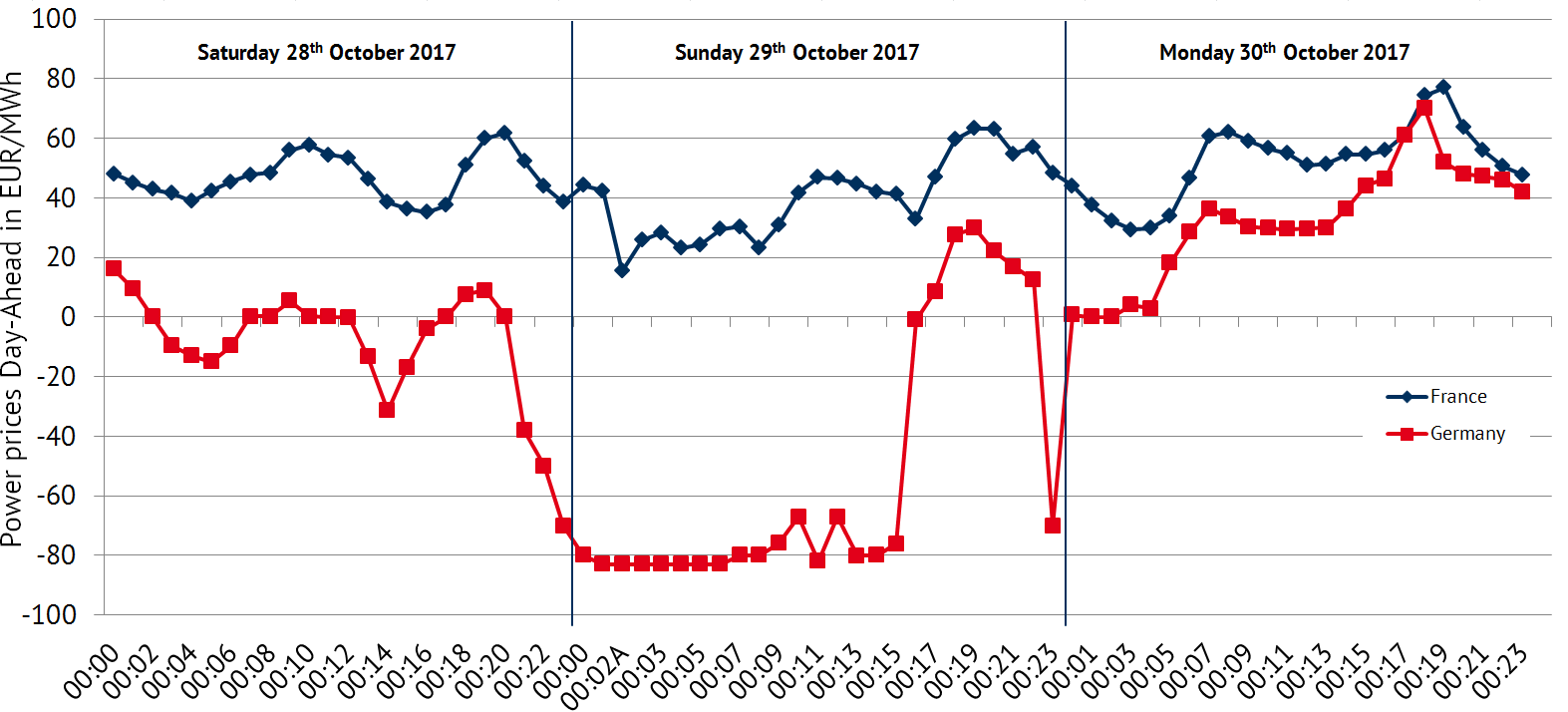In Germany, electricity prices more than 100 times in a year went down to negative values

Spot prices for electricity in Germany and France for October 28-30, 2017, statistics for the EPEX Spot exchange. Prices stayed in the negative zone for 31 consecutive hours with a minimum value of −83.06 euros per megawatt hour
Over the past two decades, Germany has invested about € 200 billion in the development of "clean" energy from renewable sources. These investments give the result. Even more than that: on some days the amount of electricity generated exceeds consumption, so there is literally no room for energy. The operator of the German power grid Tennet reported that on such days the network is experiencing great stress due to excess capacity.
According to the laws of the market, if supply exceeds demand, then the cost of goods decreases. The same thing happens with electricity prices. On one of the largest European stock exchanges, EPEX Spot, on Sunday, December 24, 2017, and on Christmas Monday, December 25, electricity spot prices again fell below zero. On Sunday, plant owners and other large consumers received more than 50 euros for each megawatt hour of electricity used by the NY Times .
Nobody paid extra to ordinary consumers. In Germany, the cost of electricity for households has increased by about 50% over the past 10 years, and the price of electricity itself amounts to only 20% of the bill for electricity. Additional money goes to taxes, network services and subsidies to companies that develop alternative energy (see the blue fragment in the columns of the diagram ).
The reason for the fall in prices below zero was the coincidence of several factors: an unusually warm winter, low demand due to weekends and holidays, as well as a good steady wind.
The excess of electricity generation is not the first time manifested in Germany, especially often this happens on weekends. Yes, and negative electricity prices are gradually becoming normal and no one is surprised. According to statistics from EPEX Spot, for 2017 spot prices fell into the negative area more than 100 times (namely, 103 times as of November 2).
Wind power generation is highly dependent on wind strength and stability. Ideally, the wind should be strong, but not too strong, and as stable as possible.
In addition to Germany, recently negative electricity prices have been recorded in other European countries: Belgium, Great Britain, France, the Netherlands and Switzerland. But in Germany, this situation occurs most often.
The problem is aggravated by the fact that a significant part of generation in Germany is provided by power plants, which cannot be quickly stopped during periods of low consumption, and then quickly launched. These are coal and nuclear power plants, as well as combined heat and power plants (CHP). A graph of the type of electricity generation during the period of negative prices shows that coal and nuclear power plants did slightly reduce the generation in this unfortunate period so that the losses were not so large. Nuclear power plants reduced generation by three gigawatts, that is, by 37%, and coal plants - from 15.7 GW to 5.5 GW. But wind turbines during this period provided 68% of electricity consumption in Germany, although this figure is usually around 12%.

Chart by type of electricity generation for the period of negative prices September 28-30, 2017
Interestingly, coal is definitely not a renewable resource. For oil, there are still questions, but with coal everything is clear - its reserves were formed at a time when microbes have not yet learned how to process cellulose from wood (most likely, the formation of large coal reserves stopped after the appearance of fungi capable of decomposing lignin). However, given current annual consumption, the world’s proven coal reserves exceed the oil reserves. It should also be borne in mind that the proven reserves of coal and oil can grow every year, as has happened recently thanks to new mining and exploration technologies. That is, reserves available for production are growing faster than current consumption. But it is clear that this can not last forever and the future of humanity - for renewable energy sources.
It is likely that it will be necessary to supplement the unstable generation of wind and solar installations with large energy storage facilities that will balance the balance. But so far, the production of batteries has not reached the required technological level. Therefore, the volume of power generation in Germany will continue to depend on the weather, and prices will periodically slide into a negative area.
All Articles